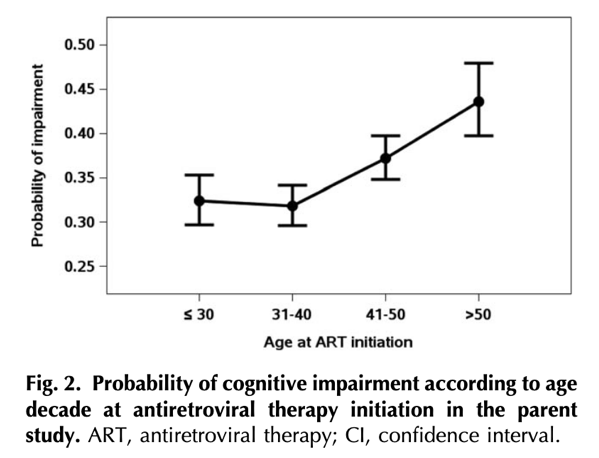| |
HIV Neurocognitive Impairment Starts at 40-50 Years Old
|
| |
| |
Download the PDF
the odds of neurocognitive impairment at follow-up visits among the HIV infected increased by nearly 20% for each decade of advancing age.....Figure 2 shows that the age-related increase in neurocognitive impairment began in the fifth decade (age 41-50).

In the multivariable adjusted model (Table 1 and Fig. 1), after correcting for the expected effects of age using norms from HIV-negative individuals, the odds of neurocognitive impairment at follow-up visits among our HIV-infected study participants increased by nearly 20% for each decade of advancing age at parent study entry [OR 1.18, (1.11-1.26), P < 0.001]. Figure 2 shows that the age-related increase in neurocognitive impairment began in the fifth decade (age 41-50). Hepatitis C infection was also associated with neurocognitive impairment [OR 1.40, (1.08-1.82), P = 0.01] along with less education [OR 1.37, (1.20-1.57), P < 0.001] time-varying CD4+ cell count level less than 350 cells/μl [OR 1.21, (1.05-1.40), P = 0.008] and time-varying CD4+ level between 351 and 500 cells/μl during follow-up [OR 1.12, (1.01-1.24), P = 0.03]. Women had greater odds of impairment than men [OR 1.35, (1.15-1.59), P < 0.001]. Variables for which the odds of impairment were not significant in the adjusted models included IDU, initial ART drug class and parent study and nadir CD4+ level.
We observed a higher rate of impairment among participants of Latino/Hispanic ethnicity.
We found that advancing age was a significant risk factor for neurocognitive impairment, even 2 or more years after starting initial ART treatment. This was true despite normative adjustment of neurocognitive scores for age from HIV-negative individuals, and after adjusting for a variety of covariates in multivariable models. This elevated risk of neurocognitive impairment with age was seen despite continued virologic suppression in most and despite overall neurocognitive improvement in the cohort as a whole. In contrast to a recent study that found that increased cognitive impairment began in the seventh decade [11], we observed an increase in risk beginning in the fifth decade.

Our findings have implications for the aging HIV-infected population on cART. Numerous prior studies have postulated premature or accelerated aging in HIV [27], but the exact mechanisms by which this might occur are unclear. Several mechanisms have been proposed. First, cART has been shown to magnify adverse effects on neurocognition of common comorbidities associated with aging, such as diabetes mellitus, hypertension, and abdominal obesity [28-31]. Second, older individuals may require higher central nervous system (CNS)-penetration ART regimens to benefit neurocognitively than younger individuals, as was shown in an older subgroup in a recent clinical trial [32]. Third, CNS toxicities of ART may have a greater impact in older participants than younger ones [33].
Although a recent study [34] did not find HCV coinfection to be significantly associated with poorer neurocognitive outcomes, our study found HCV to be a significant risk factor.
Of note, our study was conducted before direct-acting antiviral HCV agents were in use. Differences in findings between our study and previous studies may reflect our larger cohort size and greater power to detect an effect.
Future studies should evaluate potential mediators of the adverse effects of age on neurocognitive trajectories, such as inflammation, coinfections such as syphilis and cytomegalovirus, and vascular risk factors, including diabetes, hypercholesterolemia, and central obesity. Novel treatments will depend in part on which factors or combinations of these factors are driving neurocognitive impairment in HIV.
Abstract
Background: Despite treatment with virologically suppressive antiretroviral therapy (ART), neurocognitive impairment may persist or develop de novo in aging HIV-infected individuals. We evaluated advancing age as a predictor of neurocognitive impairment in a large cohort of previously ART-naive individuals on long-term ART.
Design: The AIDS Clinical Trials Group Longitudinal Linked Randomized Trials was a prospective cohort study of HIV-infected individuals originally enrolled in randomized ART trials. This analysis examined neurocognitive outcomes at least 2 years after ART initiation.
Methods: All participants underwent annual neurocognitive testing consisting of Trail making A and B, the wechsler adult intelligence scale-revised Digit Symbol and Hopkins Verbal Learning Tests. Uni and multivariable repeated measures regression models evaluated factors associated with neurocognitive performance. Predictors at parent study entry (ART naive) included entry demographics, smoking, injection drug use, hepatitis B surface antigen, hepatitis C virus serostatus, history of stroke, ART regimen type, pre-ART nadir CD4 cell count, and plasma viral load and as well as time-updated plasma viral load and CD4 cell count.
Results: The cohort comprised 3313 individuals with median pre-ART age of 38 years, 20% women; 36% Black, non-Hispanic; 22% Hispanic. Virologic suppression was maintained at 91% of follow-up visits. Neurocognitive performance improved with years of ART. After adjusting for the expected effects of age using norms from HIV-negative individuals, the odds of neurocognitive impairment at follow-up visits among the HIV infected increased by nearly 20% for each decade of advancing age.
Conclusion: Despite continued virologic suppression and neurocognitive improvement in the cohort as a whole, older individuals were more likely to have neurocognitive impairment than younger individuals.
|
|
| |
| |
|
|
|